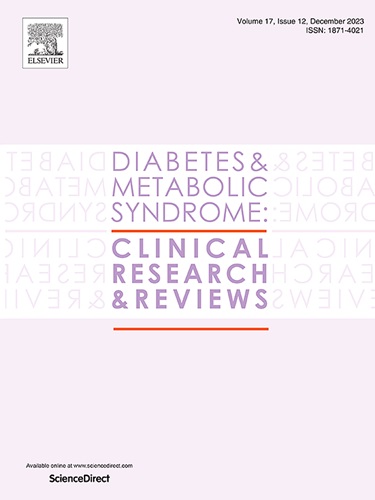Impact of type 1 diabetes mellitus on mortality rate and outcome of hospitalized patients with myocardial infarction
IF 3.4
Q1 ENDOCRINOLOGY & METABOLISM
Diabetes & Metabolic Syndrome-Clinical Research & Reviews
Pub Date : 2025-02-01
DOI:10.1016/j.dsx.2025.103201
引用次数: 0
Abstract
Introduction
Type 1 diabetes mellitus (T1D) is associated with an increased cardiovascular risk. We aimed to investigate the influence of T1D on myocardial infarction (MI) patients’ mortality.
Materials and methods
The German nationwide inpatient sample 2005–2016 was used for statistical analysis. Hospitalized MI patients were stratified for T1D and impact of T1D on in-hospital outcomes was investigated.
Results
In total, 3,307,703 hospitalizations of MI patients (37.6 % females, 56.8 % aged ≥70 years) were counted in Germany 2005–2016 and included in this analysis. In 18,625 (0.6 %) of the cases additionally T1D was coded. Overall, 410,737 (12.4 %) in-hospital deaths occurred within the investigation period. MI patients with T1D were younger (64.0 [IQR 52.0–75.0] vs. 73.0 [62.0–81.0] years, P < 0.001), more often female (38.7 % vs. 37.6 %, P < 0.001) and obese (13.2 % vs. 9.3 %, P < 0.001). Comorbidities like peripheral arterial (14.2 % vs. 6.4 %, P < 0.001) and kidney disease (38.5 % vs. 27.2 %, P < 0.001) were more prevalent in MI patients with T1D. T1D was an independent risk factor for in-hospital death (OR 1.23 [95%CI 1.18–1.29], P < 0.001), recurrent MI (OR 1.56 [95%CI 1.35–1.80], P < 0.001), and stroke (OR 1.75 [95%CI 1.63–1.88], P < 0.001). While percutaneous coronary intervention (PCI, 37.8 % vs. 42.0 %, P < 0.001) was less often, coronary artery bypass grafting (CABG, 7.4 % vs. 4.6 %, P < 0.001) was more often performed in MI patients with T1D, confirmed by regression analysis (PCI: OR 0.66 [95%CI 0.64–0.68], P < 0.001; CABG: OR 1.54 [95%CI 1.45–1.63], P < 0.001).
Conclusions
T1D represents an important and independent risk factor for mortality in MI patients. The results emphasize the high vulnerability of T1D patients who suffer from MI.
1型糖尿病对住院心肌梗死患者死亡率及转归的影响
简介1型糖尿病(T1D)与心血管风险增加有关。我们旨在研究 T1D 对心肌梗死(MI)患者死亡率的影响:采用 2005-2016 年德国全国住院病人样本进行统计分析。对住院心肌梗死患者进行T1D分层,并调查T1D对住院结果的影响:2005-2016年,德国共统计了3,307,703名住院心肌梗死患者(37.6%为女性,56.8%年龄≥70岁),并将其纳入本次分析。其中18625例(0.6%)的病例被额外编码为T1D。在调查期内,共有410737人(12.4%)在院内死亡。患有 T1D 的心肌梗死患者更年轻(64.0 [IQR 52.0-75.0] 岁 vs. 73.0 [62.0-81.0] 岁,P 结论:T1D 是心肌梗死的重要独立危险因素:T1D 是导致心肌梗死患者死亡的一个重要且独立的风险因素。研究结果表明,T1D 患者极易罹患心肌梗死。
本文章由计算机程序翻译,如有差异,请以英文原文为准。
求助全文
约1分钟内获得全文
求助全文
来源期刊

Diabetes & Metabolic Syndrome-Clinical Research & Reviews
ENDOCRINOLOGY & METABOLISM-
CiteScore
22.90
自引率
2.00%
发文量
248
审稿时长
51 days
期刊介绍:
Diabetes and Metabolic Syndrome: Clinical Research and Reviews is the official journal of DiabetesIndia. It aims to provide a global platform for healthcare professionals, diabetes educators, and other stakeholders to submit their research on diabetes care.
Types of Publications:
Diabetes and Metabolic Syndrome: Clinical Research and Reviews publishes peer-reviewed original articles, reviews, short communications, case reports, letters to the Editor, and expert comments. Reviews and mini-reviews are particularly welcomed for areas within endocrinology undergoing rapid changes.
 求助内容:
求助内容: 应助结果提醒方式:
应助结果提醒方式:


